
If you’re a low-handicapper, here’s how to fix your most common faults
By Zach Allen, PGA, Photos By David Johnston
Good golfers often struggle with very different problems than average golfers. They often hit the ball too far with their short irons and overdraw or block shots to the right because they get stuck on their downswings. Sometimes their hands are too overactive through release. It’s kind of ironic that the very things that make golfers more powerful players also give them consistency problems. If this sounds like you, and you want to fix your game, read on.
ANTI-STUCK DRILL
A lot of good players tend to blow their hips out to start the downswing, which leaves their arms lagging too far behind them. This leads to either blocked shots or “rescuing” the shot by flipping their hands to square up the club. Either way, there’s too much emphasis placed on timing, and unfortunately you can’t always time your swings perfectly. 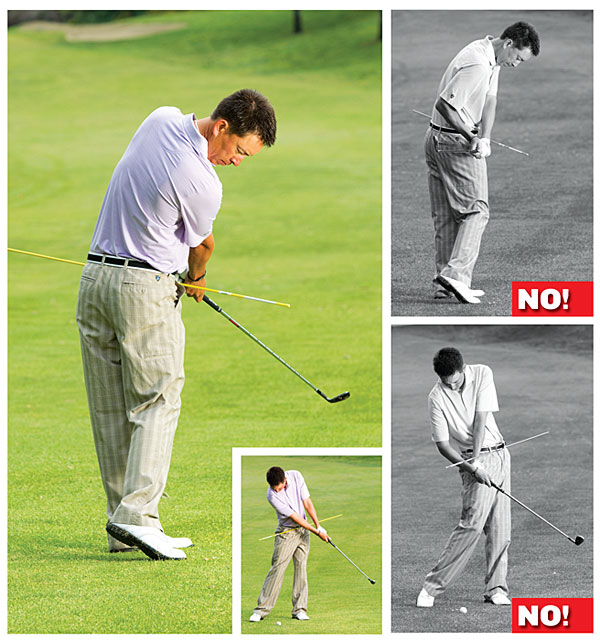
To remedy this, slip an alignment stick through a couple of your front belt loops so that it’s parallel to your target line. Then start to hit some balls. This instant-feedback drill will teach you how your hips should move throughout the swing. Feel the synchronization between your arms and hips and recognize that while your hips may lead the downswing, it’s only slightly. If you blow them out too much, as you see in the black-and-white photos above, your hands will get caught behind the stick. On the other hand, a well-synchronized swing will leave your hands in front of the stick so that you can make a swing that’s free of impediments.
RELEASE THE PUTTER
Under intense tournament pressure, it’s easy for good players to tighten their grip. Their larger muscles (shoulders, arms) tighten, and their short muscles (wrists, hands) take over. With so much pressure in the grip, the clubhead feels lighter. This leads to a putterface that opens up and blocks short putts to the right. To remedy this, it’s important to keep your body relaxed so you can feel the weight of your putterhead and use it so it releases naturally.

Try this simple drill to ingrain a light grip pressure: Grip the butt end of your club with your left forefinger and thumb while placing your right hand normally. Keep your grip pressure soft and swing back and forth, letting the head’s weight naturally release to the finish. Don’t “hit” the ball, just let it get in the way.
Once you’ve stroked a number of putts this way and developed a good feeling, return to a normal grip and make some putts. Recall that feeling of soft grip pressure and use your large muscles to control the stroke.
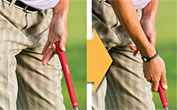
CROSSBOW DRILL
Because good players sometimes have too many moving parts in their backswing—moving their swing centers off the ball and loading too much into their right side—it’s tough to consistently make solid contact. To combat this, I suggest they try something I call the “Crossbow Drill.” 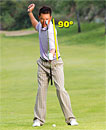
First extend your left arm in front of you while you move only your right side back. As you rotate back, take note of the resistance in your left side and head. This will help you stay more on top of the ball throughout your swing and lead to consistent strikes.
While taking some regular swings with a short club, feel as if your entire lead side and head are resisting, as your trail side turns away from the target. This will help minimize the moving parts in your backswing while still providing ample power through coil and torque.
SQUAT INTO THE GROUND FOR MORE POWER
Good players often fire their hips right from the top of their downswing and bypass what I call the “sit down position.” As a result, they stand up too quickly and have to rely on their hands and arms to square up the clubface.
If you struggle with this, try the squat drill that I’m demonstrating here. It’ll help you use the ground for more leverage, while also slowing down your overactive hips.
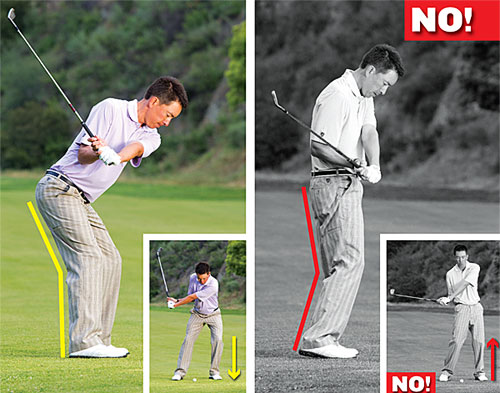
After you initiate your downswing, you should feel as if you’re actually sitting down or squatting. (If you’ve ever seen a slow-motion video of Tiger Woods from a down-the-line view, you’ve seen what I’m talking about.) This move will help stabilize your swing because your arms are allowed to move back in front of you.
CHIP FROM THE PUTTING GREEN
Good players need to find lots of opportunities to shave strokes, and this drill will help do that. First, I should note that you should be a confident, better player to pull off this drill. Chipping golf balls off a putting green can damage your golf course and anger everyone, from the greenskeeper to regular foursomes. 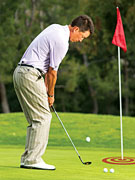
The key point with this drill is to help you understand how to use your sand wedge’s bounce so it can slide through impact. And for that to happen, the shaft has to be in the proper position at impact. If it’s too far forward, the leading edge will dig—and damage—the green. If it’s too far back, the leading edge will strike the ball first and blade it off the green.
The ideal position for a clean strike is with the shaft leaning slightly forward. This will give you a clean clip and proper trajectory. This impact position also will give you more margin for error when your contact with the ball is less than ideal.
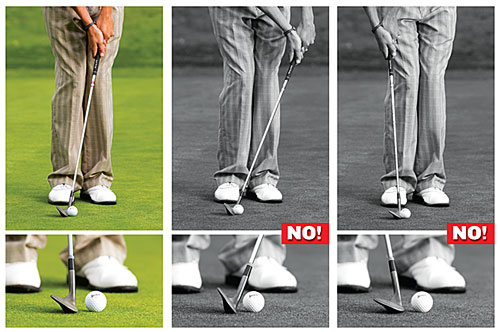
Once you’ve mastered the feeling of correctly using bounce, concentrate on trying to sink your chips. Aiming at a hole and chipping it like a putt helps you develop “make” mentality. You’re a better player, so remember you don’t want to get it close; you want to hole it. And if you’re a good player who wants to get even better, you’ve got to train your mind to always try to make it when you’re around the green. If you don’t, I guarantee you that one of your opponents will.
THE NEW LAWS OF BALLFIGHT
How do you hit a draw—with a closed clubface or an open one? You’ll likely answer, “With a closed clubface.” But unfortunately that’s not correct. You actually hit a draw with an open face. Allow me to explain.
At impact, the clubface determines the ball’s initial start direction, but it’s the swing path that determines the resulting curve. Because the laws of ballflight have been misunderstood for years, a lot of better players get this wrong. However, with the advent of technologically sophisticated launch monitors like the TrackMan, we’re now able to better understand impact.
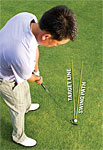
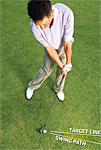
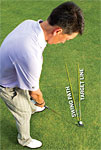
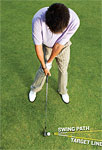
Impact for a draw is made with a slightly open clubface, and a swing path that moves from the inside to out. On the other hand, a proper fade starts with a closed clubface and a path that travels from outside to in.
The better you know these laws, the better golfers of all abilities will be able to control their ballflight and shot shape. Knowing the laws of ballflight will help you work the ball into more pin locations and doglegs, without hitting any double-crosses overdraws or push-fades. The laws of ballflight also will help you self-diagnose your swing when it’s not behaving properly.
Zach Allen, PGA, teaches at DeBell Golf Course in Burbank, Calif. A former Mini-Tour player, Allen has won 20 worldwide titles. Visit zachallengolf.com.




Thanks Zack, I really appreciate your tips on early extension of the hips, it’s a problem I’ve struggled with but didn’t realize until I videoed my swing. Great tip!!